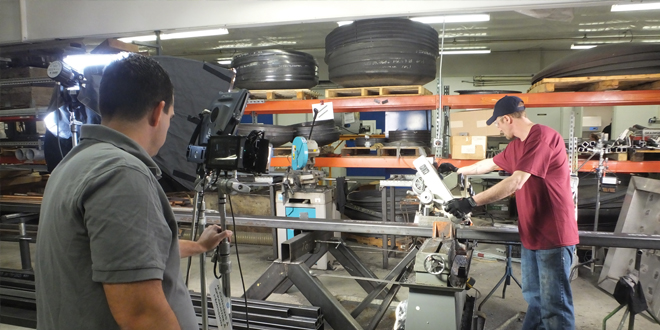Jan 22, 2016TV show will explore CO2 scrubber manufacturing process
Bryan Cook’s wife has a hard time explaining what he does for a living.
“How do I tell my friends what you do at work?” she asks him.
As the production manager at Storage Control Systems (SCS) in Sparta, Michigan, Cook often finds himself having to explain what his company does. People in the industry understand the importance of proper fruit storage, but the general public tends to take it for granted.
“If somebody picks up an apple at a Walmart in March, they think an employee just went to the back cooler, grabbed it and put it on the shelf,” Cook said. “They don’t understand everything that went into (the storage) – all the science and technology behind it.”
He’s hoping “How It’s Made” can shed a little light on the fruit storage industry and his company’s role in it. Cook would often watch the television program, which explores how everyday things are manufactured, and think: Why not Storage Control Systems?
So, he decided to contact the show. His perseverance paid off about a year later, when a film crew arrived at the SCS facility.
The story
Cook first messaged “How It’s Made” via social media and email, with no luck. He decided to take a step back and try to think like the people who make the show. What would make them want to visit SCS?
Maybe the family story would work. Cook’s grandfather started the business in the 1980s, making doors for CA (controlled atmosphere) storages. Cook’s uncle, Jim Schaefer, took over in the next decade. It’s still a family affair, with Schaefer, his son Sam and Cook all playing important roles.
Cook laid out the family history in a letter to “How It’s Made.” He also detailed how SCS has grown into an international business, and now manufactures whole buildings for CA storage, along with the insulation, refrigeration, control, lighting and monitoring equipment needed to run a modern storage facility.
Cook mailed the letter, and got a phone call from “How It’s Made” within a week. He told producers more about the company and fruit storage industry – about the process behind picking an apple in the fall, storing it and pulling it out the following July, all the while keeping it crisp and juicy.
Like a human, an apple takes in oxygen and gives off carbon dioxide (CO2). When an apple is stored in an airtight chamber, the oxygen gets used up and the CO2 levels increase. To prevent CO2 levels from getting too high, which damages apples, scrubbers are used to regulate the percentage of CO2 in the chamber, Cook said.
“How It’s Made” decided to visit SCS and film the CO2 scrubber manufacturing process. A four-man film crew arrived at the Sparta facility in November and stayed for two days. At the end of the second day, the crew visited nearby Thome Orchards for the final shot – the installation of a scrubber, nitrogen machine and monitoring equipment, Cook said.
Patrick Zaloum, the film crew’s director, has been working with “How It’s Made” for 12 years. Based in Montreal, Canada, he and his crew travel around the United States and beyond, visiting factories and plants and filming how things are made – anything from needles to trucks. Zaloum said the average trip lasts about three weeks, and the crew usually spends about a day at each plant. His team was in the middle of one such journey through the Midwest, visiting factories in Michigan, Wisconsin and Minnesota before flying back to Montreal.
Zaloum said there are multiple ways for a manufacturer to get the attention of “How It’s Made.” Usually, show representatives seek out the subjects, but occasionally a company will make a successful pitch. That’s what happened with SCS.
The film crew reads a little background information on the subject before they arrive, but they don’t finalize their creative approach until they get to the facility, he said.
“It’s better to have less knowledge of the place, so we arrive with a fresh mind,” Zaloum said.
The constant challenge for “How It’s Made” crews is figuring out how to explain each object or process in a way that’s visually interesting. There’s a certain formula to the show, but each subject requires its own unique approach, the director said.
The day before visiting SCS, for example, Zaloum’s crew filmed in a bicycle factory. That was a fairly straightforward shoot, since everybody knows what a bicycle does. SCS was a little trickier, since most people aren’t familiar with CO2 scrubbers. That’s part of the reason the crew spent two days at the Sparta facility, instead of the usual one.
Zaloum said SCS was one of the first subjects to be filmed using 4K technology, also known as Ultra High Definition.
The end result of the two-day shoot will be a four- to four-and-a-half-minute segment on a future episode of “How It’s Made,” which airs on the Discovery Channel (now known as Discovery Science in Canada and Science in the United States). Cook said the first broadcast would be this summer.
Zaloum said the episode could “go on forever” after its initial airing. Subjects filmed a dozen years ago are still on TV – and “How It’s Made” airs in almost 180 countries in 22 languages.
— Matt Milkovich, Managing Editor















